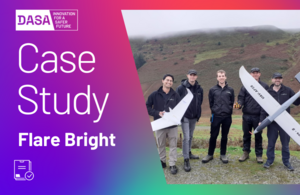Flare Bright continues to fly high
Following initial funding from the Defence And Security Accelerator (DASA) to help get it off the ground, Flare Bright has won contracts from leading aerospace companies, the UK Ministry of Defence and the United States Department of Defense.

Using its software-enhanced Inertial Navigation System (INS), Flare Bright aims to solve the problem of what happens if GPS is denied during drone operations.
After successful initial DASA funding in 2021, to prove the concept of true autonomy in drones, Flare Bright was awarded a larger follow-up contract to provide the same autonomy in powered drones to give increased persistence and endurance. This project delivered a fixed-wing drone able to fly without GPS or any remote-control while being immune to jamming. A third DASA contract was absorbed into a Defence Science Technology Laboratory (Dstl) programme.
Since then, Flare Bright has shifted its focus from developing the drones, to developing advanced software that can be used in other companies’ existing and future drones, both aerial and undersea. Flare Bright has now established a thriving defence business.
Showcasing success
As well as early stage funding and business support, DASA invited Flare Bright to exhibit on its stand at the international defence and security exhibition DSEI 2021, an opportunity to showcase its cutting-edge project to a global audience of international governments, armed forces and industry leaders. One of the many visitors to DASA’s stand was then Secretary of State for Defence Ben Wallace MP, who took the opportunity to meet the Flare Bright team.
Flare Bright was back at this year’s DSEI 2023, in September, but this time with its own stand at the show.
In a post-DSEI 2023 LinkedIn post, Flare Bright wrote: “DASA mentioned us in warm terms in their DSEI wrap-up Press Release today: ‘DASA provided initial funding for Flare Bright’s autonomous nanodrone that captures aerial intelligence in the field. Afterward, Flare Bright shifted its focus to software development and has since established a thriving defence business.’ Always good to be talked about! And we at Flare Bright thank DASA in return for their support of us back in what we can now call the early days.”
Digital twin software
Key to Flare Bright’s success is its use of software modelling to create a ‘digital twin’ of an unmanned aircraft, or drone. The software model takes into account multiple variables including the drone’s aerodynamics, propulsion and fuel use to create a digital twin of the real aircraft. It then applies machine learning algorithms in a digital twin environment to solve sensing, navigation, control and optimisation problems.
The digital twin software, with its extremely accurate representations of all the aircraft’s performance data and parameters, is then uploaded into the real drone, which uses its own sensors to measure wind and other factors as it flies.
As a result, if GPS fails, or is denied by an adversary, the drone is able continuously to measure where it is by sensing speed and external conditions, taking into account its internal software model. This gives it a constant, highly accurate internal navigation ‘fix’ on its location.
As it does not require visual information it cannot be spoofed by an adversary, as happens regularly to drones in the Ukraine conflict.
Chris Daniels, Chief Commercial Officer of Flare Bright, explained that the company models the drone by breaking it down into many small digital pieces to create a physics model - a mathematical description of a system used to make testable predictions about its behaviour. he said:
Whatever data is produced internally we can measure and compare to the physics model, so that it flies as close as possible to reality,” he said.
When we put the software in the aircraft, it knows how fast it is flying over the ground and other parameters so that it can fix its position accurately.
Flare Bright’s process of analysing flight data is much cheaper to achieve the same results than conducting physical tests and it can also be used for other purposes. “As well as flying accurately in GPS-denied areas, it enables unique capabilities for drones such as, in-flight wind sensing, regulatory and safety case assurance and for test and evaluation purposes,” Chris said.
Small business, big impact
Currently, Flare Bright, a small enterprise based near Oxford and in London, is engaged on its fourth sprint project with the US Department of Defense, conducting trials of its technology in Spain, over water (so no visual navigation) and without GPS. It also has contracts with Dstl and the MOD.
Chris said that DASA’s initial funding was important to help Flare Bright’s innovation at an early stage: as non-equity money, it was critical, he explained.
Working with DASA also opened the doors to other organisations such as Dstl. “At our DASA end-of-contract demo day, there was a lot of interest in us from other organisations,” Chris said.
Thanks to that initial DASA funding, Flare Bright continues to look up. The company’s future involves adapting its expertise in fixed wing UAVs to other aircraft, rockets and projectiles. GPS denial in the air is becoming more prevalent due to deliberate action from adversaries, from solar weather and also difficult conditions on the ground, especially in urban areas. This solution to GPS-denied activity is a key part of the Generation After Next Alternative-Navigation sector.
But it is not just in the aviation sector where Flare Bright is flying high. The company has also been asked to use its machine learning digital twin expertise in both the maritime and subsea sector and for other optimisation tasks for a wide range of technologies.